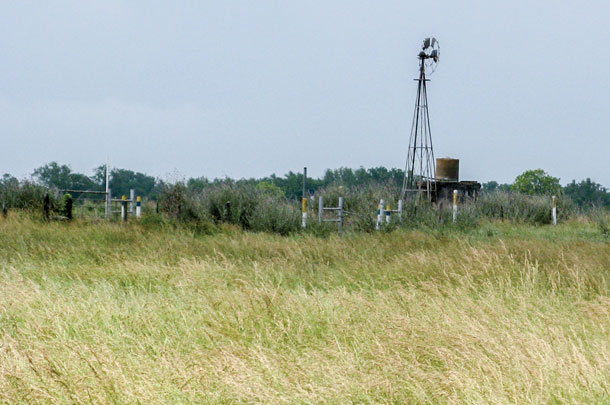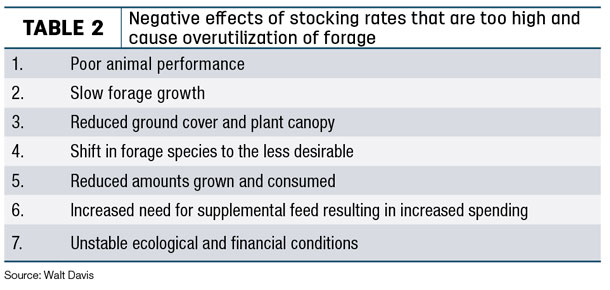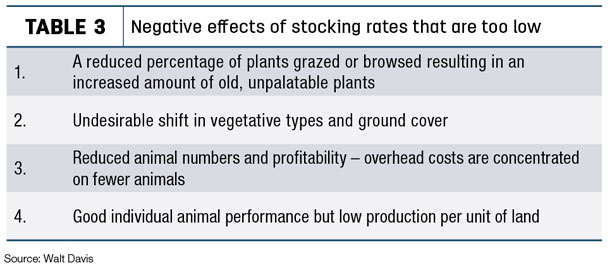He has demonstrated on his own operations and on consultant client operations that ranching and farming can be financially profitable while improving land health. Davis is author of three books, one of which is “How to Not Go Broke Ranching.”
Twelve factors which can contribute to profitability and stability of ranching were discussed by Davis and are presented in Table 1. Due to space limitations, only the first four factors are discussed in this article.
Get in sync with reality
Getting in sync with reality, the number one factor, is paying attention to the natural principles inherent in ranching. There are several of these principles, and failure to abide by them usually leads to profit losses.
Ranchers who do the best job of matching enterprises to available resources are usually the most successful. Types of resources to consider are physical, financial and human. Initiating a type of production not well adapted to any one of the three resource types is a recipe for failure.
Livestock perform best when adapted to their environment. Some environmental characteristics include climate, available forage and terrain. Most animals will eventually adapt to new environments, but production suffers during the process.
Use the type of available forage as a basis for selecting type of livestock. Species of animals differ in their diet preferences. Cattle, bison, horses, elk and some antelope prefer grass with lesser amounts of forbs and browse.
Sheep prefer a mixture of forbs and grass plus a small amount of browse, while goats and deer like browse and forbs with some grass. Forcing animals to exist on an unnatural diet causes them health problems and is a poor use of resources.
It is not possible for a rancher or anyone to spend money into prosperity. Financial strength is obtained by spending each dollar where it will reap the most dividends. For instance, leasing rather than purchasing land is a better option unless the cost of owning land is paid from sources other than ranching.
When times become tough financially, concentrate on cutting costs that won’t negatively affect income.
Planning is the most important task of a ranch manager. A producer may raise the best livestock in the world, but failure to operate the ranch from a management plan usually results in lost profit.
Strengths, weaknesses, likes and dislikes of people involved in the operation play a large role in its success or failure. Consider availability and quality of both management and labor when planning an enterprise. It is important every involved person believes in the program.
Maximize biological diversity
Biodiversity simply means life in an area consists of different types of life forms – plants and animals of all sizes. Results of biodiversity throughout the entire soil-plant-animal complex are stability and long-term productivity.
Health and productivity of a local environment is determined by conditions of the ecology processes, which are the water cycle, mineral cycle, energy flow and biological succession.
In the water cycle, water evaporates from the earth’s surface, rises into the atmosphere, cools and condenses into rain or snow, and falls again to the surface as precipitation. The water cycle becomes more effective when soil organic matter increases by death and decay of living organisms both in and on the soil.
Organic matter improves the ability of soil to absorb and retain both water and air because of improved structure. Soil particles are held together in granules by organic matter with pore space between them. Organic matter has the ability to absorb many times its own weight in water.
 Soil surface kept covered with either live or dead plant material improves water cycle efficiency because evaporation is reduced. Increased soil organic matter means more soil life, including bacteria, actinomycetes, fungus, protozoa, nematodes, arthropods and earthworms.
Soil surface kept covered with either live or dead plant material improves water cycle efficiency because evaporation is reduced. Increased soil organic matter means more soil life, including bacteria, actinomycetes, fungus, protozoa, nematodes, arthropods and earthworms.
The increased amount of soil life results in further improvement of both the water and mineral (nutrient) cycles.
Mineral nutrients cycle through the soil-plant-animal complex. They are absorbed by plants and formed into compounds; eaten as forage by large and small grazers; excreted in manure and urine; decomposed by insects, bacteria and fungi; and finally reabsorbed by plants.
Amounts and types of minerals in the cycle depend upon the soil nutrient content, but soil organism population health, vegetation diversity and uniformity of vegetation utilization are also critical factors.
Energy does not cycle but rather flows through the ecological system. Solar energy as sunlight is converted into biological energy by green plants through photosynthesis. Green forage is consumed by grazing animals, and the energy is used to produce animal tissue.
The animal tissue is later consumed by other organisms such as man, carnivores and flesh-eating bacteria, with the byproducts of this consumption decomposed by a series of soil organisms.
Flow-through means the system requires constant infusions of energy to remain healthy. The higher the amount of solar energy captured and converted to biological energy, the more life the system supports. Key to increasing energy flow is to have green and growing vegetation available to solar radiation as much as feasible.
Pastures containing a mixture of plants with different growth habits normally capture and convert more solar energy than those with less plant diversity. In addition, a wide diversity of plants utilized by grazing animals increases forage intake and improves animal production.
Planned grazing
Planned grazing management is the most powerful and cost-effective tool available for increasing profitability and stability of ranching operations. The unique value of grazing, when properly applied and monitored, can simultaneously increase financial profitability and ecological health.
Grazing plans are designed and operated differently depending upon the area, but the overall principles are the same. Planned grazing is focused on accomplishing predetermined and desired results. The plan must account for all animals present during the grazing season, domestic and wild.
Stocking rates should match the amount of available forage to avoid overuse or underuse of the pasture. Select a degree of grazing intensity that leaves enough green leaf material to promote forage regrowth.
Employ some type of pasture rotation system to allow time for forage to recover from grazing effects. Negative effects of stocking rates that are either too high or too low are shown in Tables 2 and 3.

Substitute management for money
Good management can negate the need to spend more money. For instance, a dense forage cover on pastures prohibits or retards growth of undesirable plants, reducing the need for herbicides. Internal parasites are not a problem when cattle are frequently moved to clean pastures and a 3-inch stubble is left in grazed pastures.
Managing to prevent parasite infestations eliminates or reduces the need for wormers.
Supplemental feed is a big cost problem when it becomes a substitution. An economical advantage available to ranchers is the ability to turn low-cost forage into a high-value product such as beef. The need to substitute feed for grazing is a red warning flag of potential financial disaster.
Weaning the heaviest calves in the county can provide bragging rights, but it may not be the most economical practice. Big cows have larger calves than small cows. They also eat more, wean a smaller percentage of their bodyweight in calf, wean fewer calves due to calving difficulty and have poorer breed-back percentages. Chasing productivity is not always good business.
It is very easy to get caught up in the practices and processes of running a ranch and lose sight of the operation’s purpose. Ranching is a business that needs to be run like a business. ![]()
PHOTO 1: Big cows and calves may not be most economical.
PHOTO 2: Stocking rates should match the amount of available forage. Photo provided by Robert Fears.
Robert Fears is a freelance writer based in Georgetown, Texas. Email Robert Fears.







